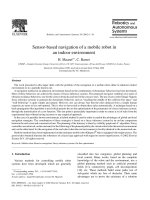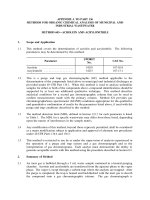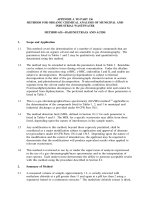New Trends in Technologies: Devices, Computer, Communication and Industrial Systems doc
Bạn đang xem bản rút gọn của tài liệu. Xem và tải ngay bản đầy đủ của tài liệu tại đây (44.35 MB, 454 trang )
New Trends in
Technologies:
Devices, Computer,
Communication and
Industrial Systems
edited by
Prof. Meng Joo Er
SC I YO
New Trends in Technologies: Devices, Computer,
Communication and Industrial Systems
Edited by Prof. Meng Joo Er
Published by Sciyo
Janeza Trdine 9, 51000 Rijeka, Croatia
Copyright © 2010 Sciyo
All chapters are Open Access articles distributed under the Creative Commons Non Commercial Share
Alike Attribution 3.0 license, which permits to copy, distribute, transmit, and adapt the work in any
medium, so long as the original work is properly cited. After this work has been published by Sciyo,
authors have the right to republish it, in whole or part, in any publication of which they are the author,
and to make other personal use of the work. Any republication, referencing or personal use of the work
must explicitly identify the original source.
Statements and opinions expressed in the chapters are these of the individual contributors and
not necessarily those of the editors or publisher. No responsibility is accepted for the accuracy of
information contained in the published articles. The publisher assumes no responsibility for any
damage or injury to persons or property arising out of the use of any materials, instructions, methods
or ideas contained in the book.
Publishing Process Manager Jelena Marusic
Technical Editor Teodora Smiljanic
Cover Designer Martina Sirotic
Image Copyright Palto, 2010. Used under license from Shutterstock.com
First published November 2010
Printed in India
A free online edition of this book is available at www.sciyo.com
Additional hard copies can be obtained from
New Trends in Technologies: Devices, Computer, Communication and Industrial Systems,
Edited by Prof. Meng Joo Er
p. cm.
ISBN 978-953-307-212-8
SC I YO.C O M
WHERE KNOWLEDGE IS FREE
free online editions of Sciyo
Books, Journals and Videos can
be found at www.sciyo.com
Chapter 2
Chapter 3
Chapter 4
Chapter 5
Chapter 6
Chapter 7
Chapter 8
Chapter 9
Chapter 10
Chapter 11
Preface IX
Overview of Multi Functional Materials 1
Parul Gupta and R.K.Srivastava
Polymer Materials and Its Properties 15
Jana Šišáková
New Technologies and Devices
to Increase Structures’ Safety to Dynamic Actions 43
Viorel Serban, Madalina Zamfi r, Marian Androne and George Ciocan
Advances in CAD/CAM Technologies 67
Mircea Viorel Drăgoi
Computer Simulation of Plaque Formation
and Development in the Cardiovascular Vessels 95
Nenad Filipovic
Economic Impact of Information and Communications Technology –
Identifying Its Restraints and Exploring Its Potential 119
Ksenija Vuković and Zoran Kovačević
Operating System Kernel Coprocessor for Embedded Applications 135
Domen Verber and Matjaž Colnarič
Modern Internet Based Production Technology 145
Dobroslav Kováč, Tibor Vince, Ján Molnár and Irena Kováčová
eLearning and Phantasms 165
M.sc. Ivan Pogarcic and B.sc. Maja Gligora Markovic
Model of the New LMS Generation with User-Created Content 179
Dragan Perakovic, Vladimir Remenar and Ivan Jovovic
BEPU Approach in Licensing Framework,
including 3D NK Applications 197
F. D’Auria, N. Muellner, C. Parisi and A. Petruzzi
Contents
Chapter 12
Chapter 13
Chapter 14
Chapter 15
Chapter 16
Chapter 17
Chapter 18
Chapter 19
Chapter 20
Chapter 21
Chapter 22
A Review on Oscillatory Problems in Francis Turbines 217
Hermod Brekke
Capabilities and Performances
of the Selective Laser Melting Process 233
Sabina L. Campanelli, Nicola Contuzzi,
Andrea Angelastro and Antonio D. Ludovico
Experimental Analysis of the Direct Laser Metal Deposition Process 253
Antonio D. Ludovico, Andrea Angelastro and Sabina L. Campanelli
Low-Shock Manipulation and Testing
of Micro Electro-Mechanical Systems (MEMS) 273
Carlo Ferraresi, Daniela Maffi odo, Francesco Pescarmona,
Omar Bounous, Luciano Bonaria and Maurizio Straiotto
Magnetically Nonlinear Dynamic Models of Synchronous Machines:
Their Derivation, Parameters and Applications 291
Gorazd Štumberger, Bojan Štumberger, Tine Marčič
Miralem Hadžiselimović and Drago Dolinar
Potential for Improving HD Diesel Truck Engine Fuel
Consumption Using Exhaust Heat Recovery Techniques 313
D.T. Hountalas and G.C. Mavropoulos
New Trends in Effi ciency Optimization of Induction Motor Drives 341
Branko Blanusa
Modelling of Concurrent Ddevelopment of the Products,
Processes and Manufacturing Systems in Product Lifecycle Context 359
Jan Duda
Printing as an Alternative Manufacturing Process
for Printed Circuit Boards 375
Huw J Lewis and Alan Ryan
Recent Development of Fast Numerical Solver for Elliptic Problem 403
Mohammad Khatim Hasan, Jumat Sulaiman,
Samsul Ariffi n Abdul Karim, and Mohamed Othman
The Role of Computer Games Industry and Open Source Philosophy
in the Creation of Affordable Virtual Heritage Solutions 421
Andrea Bottino and Andrea Martina
VI
From the metallurgists who ended the Stone Age to the shipbuilders who united the world’s
peoples through travel and trade, the past witnessed many marvels of engineering prowess. As
civilization grew, it was nourished and enhanced with the help of increasingly sophisticated
tools for agriculture, technologies for producing textiles, and inventions transforming human
interaction and communication. Inventions such as the mechanical clock and the printing
press irrevocably changed civilization.
In the modern era, the Industrial Revolution brought engineering’s infl uence to every niche
of life, as machines supplemented and replaced human labor for countless tasks, improved
systems for sanitation enhanced health, and the steam engine facilitated mining, powered
trains and ships, and provided energy for factories.
In the century just ended, engineering recorded its grandest accomplishments. The widespread
development and distribution of electricity and clean water, automobiles and airplanes, radio
and television, spacecraft and lasers, antibiotics and medical imaging, and computers and the
Internet are just some of the highlights from a century in which engineering revolutionized
and improved virtually every aspect of human life.
In this book entitled “New Trends in Technologies: Devices, Computers, Communications
and Industrial Systems’, the authors provide a glimpse of the new trends of technologies
pertaining to devices, computers, communications and industrial systems. The book comprised
of 22 very interesting and excellent articles covers core topics ranging from “Overview of
Multifucntional Materials” to “New Technologies and Devices to Increase Structures’ Safety
to Dynamic Actions in Devices”, “Advances in CAD/CAM Technologies” to “Operating
System Kernel Coprocessor for Embedded Applications” in Computers and “Modern Internet-
based Production Technology” to “BEPU Approach in Licensing Framework including 3D
NK Applications” in Communication. It also covers topics pertaining to industrial systems
ranging from “A Review of Work on Oscillatory Problems in Francis Turbines” to “The Role
of Gaming Theory and Open Source Philosophy in the Creation of Affordable Virtual Heritage
Solutions”. The book will serve a unique purpose through these multi-disciplinary topics to
share different but interesting views on each of these exciting topics which form the backbone
of Engineering Challenges for the 21St Century.
I would like to thank all the authors for their excellent contributions in the different areas of
their expertise. It is their domain knowledge, enthusiastic collaboration and strong support
which made the creation of this book possible. I sincerely hope that readers of all disciplines
will fi nd this book valuable.
Editor
Professor Meng Joo Er
School of Electrical and Electronic Engineering
Nanyang Technological University
Preface
1
Overview of Multi Functional Materials
Parul Gupta
1
and R.K.Srivastava
2
1
Department of Mechanical Engineering, Moradabad Institute of Technology (Uttar
Pradesh Technical University), Moradabad, Uttar Pradesh,
2
Department of Mechanical Engineering, Motilal Nehru National Institute of Technology
(Deemed University), Allahabad, Uttar Pradesh,
India
1. Introduction
Until relatively recent times, most periods of technological development have been linked to
changes in the use of materials (eg the stone, bronze and iron ages). In more recent years the
driving force for technological change in many respects has shifted towards information
technology. This is amply illustrated by the way the humble microprocessor has built
intelligence into everyday domestic appliances. However, it is important to note that the IT
age has not left engineered materials untouched, and that the fusion between designer
materials and the power of information storage and processing has led to a new family of
engineered materials and structures.
The development of materials science has lead to the introduction of a new kind of material-
“smart” material. Smart materials not only have the traditional structural material functions.
But also have functions such as actuation, sensibility and microprocessing capability. in the
materials family , we find three major materials : metals .ceramic and polymer and among
those polymers being the youngest members find wide application in comparison to
metals and ceramics In every sectors of our society . the recent progress in smart materials
has taken the new momentum in the materials science and technology .the board spectrum
of applications of smart materials cover the biomedical , environmental , communication
defence , space , nanotechnolgical fields of research with tremendous progress . The present
report describes the application of smart materials in terms of opportunity and future
challenges.
Smart materials referred to materials that will undergo controlled transformations through
physical interactions. Smart Materials are materials that respond to environmental stimuli,
such as temperature, moisture, pH, or electric and magnetic fields. For example-
photochromic materials that change colour in response to light; shape memory alloys and
polymers which change/recover their shape in response to heat and electro- and magneto-
rheological fluids that change viscosity in response to electric or magnetic stimuli. Smart
Materials can be used directly to make smart systems or structures or embedded in
structures whose inherent properties can be changed to meet high value-added performance
needs.The different types of smart materials include piezoelectric, shape-memory alloys,
electro-active conductive polymers, electrochromic materials, biomaterials,
New Trends in Technologies: Devices, Computer, Communication and Industrial Systems
2
1.1 Needs of smart materials
To achieve a specific objective for a particular function or application, a new material or
alloy has to satisfy specific qualifications related to the following properties:-
a. Technical properties, including mechanical characteristics such as plastic flow, fatigue
and yield strength and behavioural characteristics such as damage tolerance and
electrical, heat and fire resistance.
b. Technological properties, encompassing manufacturing, forming, welding abilities,
thermal processing, waste level, workability, automation and repair capacities.
c. Economic criteria, related to raw material and production costs, supply expenses and
availability.
d. Environmental characteristics, including features such as toxicity and pollution.
e. Sustainable development criteria, implying reuse and recycling capacities. If the
functions of sensing and actuation are added to the list, then the new material/alloy is
considered a smart material.
2. Classification of smart materials
Types of materials
a. Piezoelectric Materials
b. Shape memory alloy (SMA)
c. Electro-active conductive polymers
d. Biomaterials,
e. Electro-rheological fluids
Piezoelectric materials, shape-memory alloys, electrostrictive materials, magnetostrictive
materials, electro-rheological fluids, etc. are currently available smart materials.
2.1 Piezoelectric materials
Piezoelectric materials were first discovered by Jacques and Pierre Curie in the 19
th
century.
The literal meaning of piezoelectric is “pressure electricity”, and this meaning aptly
describes these materials, as a deformation caused by pressure on the substance will create
an electric current within the material. The mechanical pressure is therefore converted to
voltage. Natural piezoelectric materials are crystalline materials that exhibit the piezoelectric
effect. Often they are strong physically and chemically inert. The piezoelectric effect can
also be found in synthetic polycrystalline ceramics which can be designed to have other
specific properties that make individual ceramics useful in many different
applications. Piezoelectric materials are often linked to pyroelectric effects. Often a material
can undergo both effects - one converting mechanical stress energy into electrical energy
and the other converting from heat energy. A piezoelectric material does not, however,
always show the pyroelectric effect as well as the piezo.
Piezoelectric materials have two unique properties which are interrelated. When a
piezoelectric material is deformed, it gives off a small but measurable electrical discharge.
Alternately, when an electrical current is passed through a piezoelectric material it experiences
a significant increase in size (up to a 4% change in volume). Piezoelectric materials are most
widely used as sensors in different environments. They are often used to measure fluid
compositions, fluid density, fluid viscosity, or the force of an impact. An example of a
piezoelectric material in everyday life is the airbag sensor in your car. The material senses the
force of an impact on the car and sends and electric charge deploying the airbag.
Overview of Multi Functional Materials
3
2.2 How do it works
Piezoelectric materials have two crystalline configurations. One structure is organized, while
the other is not. Organization of the structure has to do with polarization of the molecules that
make up the material. Hence, a non-polarized material has a non-organized structure, while
the polarized material is organized. To polarize the material, voltage or electricity must be
conducted through it. As a result of this electrical force, the molecules of the material reorient
themselves, thus changing the shape of the material; this is called electrostriction. The picture
below shows this process at a microscopic level. Change in shape can produce mechanical
force, as well as changes in physical characteristics (like density, shown below).
Non-polarized material: Polarized material:
Electricity is produced with
Input of electricity
shape change is produced with
input of shape change.
Fig. 1.
Similarly, if mechanical force is exerted on the material to change its shape, an electrical field
is produced; this is called piezoelectric effect. Electrostriction and piezoelectric effect are
opposite phenomena. In the graphic below, a thin piezoelectric material within a plastic
sheath is being bent, and electricity is being generated and passed through the red wires at
the PZT is the most popular piezoelectric material in use.
Fig. 2.
Its physical properties can be optimized for certain applications by controlling the chemistry and
processing of this material. Therefore, it can have a variety of compositions, geometries, and
applications. Limitations in its use are related to high excitation voltages needed, mechanical
durability, and stability in coupling the material to the control system and/or structure.
Some piezoelectric materials are:
• Quartz
• Barium titanate
• Cadmium sulfide
• Lead zirconium titanate (PZT)
• Piezoelectric polymers (PVDF, PVC)
Piezoelectric effects. Electric charge is created when the material is mechanical stressed.
New Trends in Technologies: Devices, Computer, Communication and Industrial Systems
4
2.3 The piezoelectric effect
A piezoelectric substance is one that produces an electric charge when a mechanical stress is
applied (the substance is squeezed or stretched). Conversely, a mechanical deformation (the
substance shrinks or expands) is produced when an electric field is applied. This effect is
formed in crystals that have no center of symmetry. To explain this, we have to look at the
individual molecules that make up the crystal. Each molecule has a polarization, one end is
more negatively charged and the other end is positively charged, and is called a dipole. This
is a result of the atoms that make up the molecule and the way the molecules are shaped.
The polar axis is an imaginary line that runs through the center of both charges on the
molecule. In a monocrystal the polar axes of all of the dipoles lie in one direction. The crystal
is said to be symmetrical because if you were to cut the crystal at any point, the resultant
polar axes of the two pieces would lie in the same direction as the original. In a polycrystal,
there are different regions within the material that have a different polar axis. It is
asymmetrical because there is no point at which the crystal could be cut that would leave
the two remaining pieces with the same resultant polar axis. Figure 3 illustrates this concept.
Fig. 3. Mono vs. Crystals
In order to produce the piezoelectric effect, the polycrystal is heated under the application of
a strong electric field. The heat allows the molecules to move more freely and the electric
field forces all of the dipoles in the crystal to line up and face in nearly the same direction
(Figure 4).
Fig. 4. Polarization of Ceramic Material to Generate Piezoelectric Effect
The piezoelectric effect can now be observed in the crystal. Figure 5 illustrates the
piezoelectric effect. Figure 5a shows the piezoelectric material without a stress or charge. If
the material is compressed, then a voltage of the same polarity as the poling voltage will
appear between the electrodes (b). If stretched, a voltage of opposite polarity will appear (c).
Conversely, if a voltage is applied the material will deform. A voltage with the opposite
polarity as the poling voltage will cause the material to expand, (d), and a voltage with the
same polarity will cause the material to compress (e). If an AC signal is applied then the
material will vibrate at the same frequency as the signal (f).
Overview of Multi Functional Materials
5
Fig. 5. Example of Piezoelectric Effect
Using the Piezoelectric Effect -The piezoelectric crystal bends in different ways at different
frequencies. This bending is called the vibration mode. The crystal can be made into various
shapes to achieve different vibration modes. To realize small, cost effective, and high
performance products, several modes have been developed to operate over several
frequency ranges. These modes allow us to make products working in the low kHz range up
to the MHz range. Figure 6 shows the vibration modes and the frequencies over which they
can work. An important group of piezoelectric materials are ceramics. Murata utilizes these
various vibration modes and ceramics to make many useful products, such as ceramic
resonators, ceramic bandpass filters, ceramic discriminators, ceramic traps, SAW filters, and
buzzers.
2.4 Application of piezoelectric materials
Piezoelectric materials may be used passively as sensors, or actively as actuators. The
piezoelectric sensors that will be used on this bridge include the PZT (lead-zirconate-
titanate), a ceramic sensor, and PVDF (polyvinylidene fluoride), a polymeric sensor. The
PZT’s are extremely sensitive and very accurate, but due to their brittle nature, PZT’s are
restricted to being point sensors. Likewise, PVDF’s are also very sensitive and accurate.
However, PVDF’s are not as brittle and may be integrated to perform distributed
measurements. Therefore, PZT’s will be located primarily in critical areas, whereas the
PVDF’s will be located along side the strain gauges.
2.5 Shape memory alloy (SMA)
Shape memory alloys were discovered in 1932, however it was not until 1961 when the most
common form was discovered - nickel-titanium (NiTi)Several NiTi products are can be seen
in the picture to the right. A shape memory alloy (SMA) is a material that has the ability to
New Trends in Technologies: Devices, Computer, Communication and Industrial Systems
6
return to its previous shape after being deformed (bent) by applying heat or in some cases
just releasing the stress. Shape Memory Alloys (SMA's) are novel materials which have the
ability to return to a predetermined shape when heated. When an SMA is cold, or below its
transformation temperature, it has a very low yield strength and can be deformed quite
easily into any new shape which it will retain. However, when the material is heated above
its transformation temperature it undergoes a change in crystal structure which causes it to
return to its original shape. If the SMA encounters any resistance during this transformation,
it can generate extremely large forces. This phenomenon provides a unique mechanism for
remote actuation.
The most common shape memory material is an alloy of nickel and titanium called Nitinol.
This particular alloy has very good electrical and mechanical properties, long fatigue life,
and high corrosion resistance. As an actuator, it is capable of up to 5% strain recovery and
50,000 psi restoration stress with many cycles. By example, a Nitinol wire 0.020 inches in
diameter can lift as much as 16 pounds. Nitinol also has the resistance properties which
enable it to be actuated electrically by joule heating. When an electric current is passed
directly through the wire, it can generate enough heat to cause the phase transformation. In
most cases, the transition temperature of the SMA is chosen such that room temperature is
well below the transformation point of the material. Only with the intentional addition of
heat can the SMA exhibit actuation. In essence, Nitinol is anactuator, sensor, and heater all
in one material.Shape memory alloys, however, are not for all applications. One must take
into account the forces, displacements, temperature conditions, and cycle rates required of a
particular actuator. The advantages of Nitinol become more pronounced as the size of the
application decreases. Large mechanisms may find solenoids, motors, and electromagnets
more appropriate. But in applications where such actuators can not be used, shape memory
alloys provide an excellent alternative. There are few actuating mechanisms which produce
more useful work per unit volume than Nitinol. Nitinol is available in the form of wire, rod
and bar stock, and thin film. Examples of SMA products developed by TiNi Alloy Company
include silicon micro-machined gas flow microvalves, non-explosive release devices, tactile
feedback device (skin stimulators), and aerospace latching mechanisms. If you are
considering an application for shape memory alloys, TiNi Alloy Company can assist you in
the design, prototyping, and manufacture of actuators and devices.
Physical Properties of Nitinol
• Density: 6.45gms/cc
• Melting Temperature: 1240-1310° C
• Resistivity (hi-temp state): 82 uohm-cm
• Resistivity (lo-temp state): 76 uohm-cm
• Thermal Conductivity: 0.1 W/cm-° C
• Heat Capacity: 0.077 cal/gm-° C
• Latent Heat: 5.78 cal/gm; 24.2 J/gm
• Magnetic Susceptibility (hi-temp): 3.8 uemu/gm
• Magnetic Susceptibility (lo-temp): 2.5 uemu/gm
Mechanical Properties of Nitinol
• Ultimate Tensile Strength: 754 - 960 MPa or 110 - 140 ksi
• Typical Elongation to Fracture: 15.5 percent
• Typical Yield Strength (hi-temp): 560 MPa, 80 ksi
Overview of Multi Functional Materials
7
• Typical Yield Strength (lo-temp): 100 MPa, 15 ksi
• Approximate Elastic Modulus (hi-tem): 75 GPa, 11 Mpsi
• Approximate Elastic Modulus (lo-temp): 28 GPa, 4 Mpsi
• Approximate Poisson's Ratio: 0.3
Actuation
• Energy Conversion Efficiency: 5%
• Work Output: ~1 Joule/gram
• Available Transformation Temperatures: -100 to +100° C
Stress-Strain Characteristics of Nitinol at Various Temperatures
Fig. 6.
2.6 How do shape memory alloys works
In order to understand the way in which the shape memory effect occurs it is useful to
understand the crystal structure of a SMA. All shape memory alloys exhibit two very
distinct crystal structures. Which phase is present depends on the temperature and the
amount of stress being applied to the SMA. These phases as known as marten site which
exists at lower temperatures and austenite for higher temperatures. The properties of an
SMA depends on which the amount of each crystal phase present.
The two unique properties described above are made possible through a solid state phase
change that is a molecular rearrangement, which occurs in the shape memory alloy.
Typically when one thinks of a phase change a solid to liquid or liquid to gas change is the
first idea that comes to mind. A solid state phase change is similar in that a molecular
rearrangement is occurring, but the molecules remain closely packed so that the substance
remains a solid. In most shape memory alloys, a temperature change of only about 10°C is
necessary to initiate this phase change. The two phases, which occur in shape memory
alloys are Martensite, Austenite. Martensite is the relatively soft and easily deformed phase
of shape memory alloys, which exists at lower temperatures. The molecular structure in this
phase is twinned which the configuration is shown in the middle of Figure 4. Upon
deformation this phase takes on the second form shown in Figure 4, on the right. Austenite,
New Trends in Technologies: Devices, Computer, Communication and Industrial Systems
8
the stronger phase of shape memory alloys, occurs at higher temperatures. The shape of the
Austenite structure is cubic, the structure shown on the left side of Figure 4. The un-
deformed Martensite phase is the same size and shape as the cubic Austenite phase on a
macroscopic scale, so that no change in size or shape is visible in shape memory alloys until
the Martensite is deformed.
Fig. 7. The Martensite and Austenite phases
Fig. 8. Microscopic and Macroscopic Views of the Two Phases of Shape Memory Alloys
The temperatures at which each of these phases begin and finish forming are represented by
the following variables: Ms, Mf, As, Af. The amount of loading placed on a piece of shape
memory alloy increases the values of these four variables as shown in Figure 9. The initial
values of these four variables are also dramatically affected by the composition of the wire
(i.e. what amounts of each element are present).
Overview of Multi Functional Materials
9
Fig. 9. The Dependency of Phase Change Temperature on Loading
Fig. 10. Microscopic Diagram of the Shape Memory Effect
2.7 Shape memory effect
The shape memory effect is observed when the temperature of a piece of shape memory alloy
is cooled to below the temperature Mf. At this stage the alloy is completely composed of
Martensite which can be easily deformed. After distorting the SMA the original shape can be
recovered simply by heating the wire above the temperature Af. The heat transferred to the
New Trends in Technologies: Devices, Computer, Communication and Industrial Systems
10
wire is the power driving the molecular rearrangement of the alloy, similar to heat melting ice
into water, but the alloy remains solid. The deformed Martensite is now transformed to the
cubic Austenite phase, which is configured in the original shape of the wire.
The Shape memory effect is currently being implemented in:
• Coffepots
• The space shuttle
• Thermostats
• Vascular Stents
• Hydraulic Fittings (for Airplanes
Shape Memory Effect (SME) is a unique property of certain alloys exhibiting martensitic
transformation. Even though the alloy is deformed in the low temperature phase, it recovers
its original shape upon heating to a critical temperature known as the Reverse
Transformation Temperature (RTT). They are most commonly Nitinol, or nickel and
titanium combined. Less popular but still possessing the shape memory effect are gold
cadmium, silver cadmium, copper-aluminum-nickel, copper tin, copper zinc, and copper-
zinc-aluminum. The same alloys have another unique property called superelasticity (SE) at
a higher temperature. It is a large (0-18%) nonlinear recoverable strain upon loading
(stretching) and unloading (unstretchiung).
The basic one-way shape memory effect-The actual mechanism of the shape memory effect
can be described simply as a reversible, thermoelastic, phase transformation between a
parent austenitic phase and a martensitic phase. The phase transformation occurs when a
material in the austenitic phase is cooled below the martensite start temperature (Ms), where
the two phases coexist. The material must then accommodate the two phases without
changing shape through a mechanism called twinning. This is where mirror-image lattices
form adjacent to the parent lattices. The phase transformation is completed upon reaching
the martensite finish temperature (Mf). The material can then be plastically deformed into
another shape. During this deformation the twinned martensite is converted to a deformed
martensite. The material remains deformed until it is heated to the austenite start
temperature (As), and at this point the martensite begins to transform back into austenite.
Heating above the austenite finish temperature (Af) allows the material to regain its original
shape. (The extent to which the shape is regained usually depends on the type of SMA,
amount of deformation, and the material’s thermomechanical history.) When cooled again
the material does not automatically revert to the deformed shape. This is called the oneway
shape memory effect. The entire shape memory process can be repeated.
2.8 Advantages and disadvantages of shape memory alloys
Some of the main advantages of shape memory alloys include:
• Bio-compatibility
• Diverse Fields of Application
• Good Mechanical Properties (strong, corrosion resistant)
There are still some difficulties with shape memory alloys that must be overcome before
they can live up to their full potential. These alloys are still relatively expensive to
manufacture and machine compared to other materials such as steel and aluminum. Most
SMA's have poor fatigue properties; this means that while under the same loading
conditions (i.e. twisting, bending, compressing) a steel component may survive for more
than one hundred times more cycles than an SMA element.
Overview of Multi Functional Materials
11
2.9 Applications for shape memory alloys
Bioengineering:
Bones: Broken bones can be mended with shape memory alloys. The alloy plate has a
memory transfer temperature that is close to body temperature, and is attached to both ends
of the broken bone. From body heat, the plate wants to contract and retain its original shape,
therefore exerting a compression force on the broken bone at the place of fracture. After the
bone has healed, the plate continues exerting the compressive force, and aids in
strengthening during rehabilitation. Memory metals also apply to hip replacements,
considering the high level of super-elasticity. The photo above shows a hip replacement.
Reinforcement for Arteries and Veins: For clogged blood vessels, an alloy tube is crushed
and inserted into the clogged veins. The memory metal has a memory transfer temperature
close to body heat, so the memory metal expands to open the clogged arteries.
Fig. 11.
Dental wires: used for braces and dental arch wires, memory alloys maintain their shape
since they are at a constant temperature, and because of the super elasticity of the memory
metal, the wires retain their original shape after stress has been applied and removed.
Fire security and Protection systems: Lines that carry highly flammable and toxic fluids and
gases must have a great amount of control to prevent catastrophic events. Systems can be
programmed with memory metals to immediately shut down in the presence of increased
heat. This can greatly decrease devastating problems in industries that involve
petrochemicals, semiconductors, pharmaceuticals, and large oil and gas boilers.
Fig. 12.
New Trends in Technologies: Devices, Computer, Communication and Industrial Systems
12
Tubes, Wires, and Ribbons: For many applications that deal with a heated fluid flowing
through tubes, or wire and ribbon applications where it is crucial for the alloys to maintain
their shape in the midst of a heated environment, memory metals are ideal.
3. Applications of smart materials
• Piezoelectric materials - These ceramics or polymers are character-ized by a swift, linear
shape change in response to an electric field. The electricity makes the material expand
or contract almost instantly. The materials have potential uses in actuators that control
chatter in precision machine tools, improved robotic parts that move faster and with
greater accuracy, smaller microelectronic circuits in machines ranging from computers
to photolithography printers, and health-monitoring fibers for bridges, buildings, and
wood utility poles.
• Electrostrictive and magnetostrictive materials - This refers to the material quality of
changing size in response to either an electric or magnetic field, and conversely,
producing a voltage when stretched. These materials show promise in applications
ranging from pumps and valves, to aerospace wind tunnel and shock tube
instrumentation and landing gear hydraulics, to biomechanics force measurement for
ortho-pedic gait and posturography, sports, ergonomics, neurology, cardiology, and
rehabilitation.
• Rheological materials - Smart materials encompass not only solids but also fluids,
electrorheological and magnetorheological fluids that can change state instantly
through the application of an electric or magnetic charge. These fluids show promise in
shock absorbers, dampers for vehicle seats and exercise equipment, and optical
finishing.
• Thermoresponsive materials - Shape memory alloys, the dominant smart material,
change shape in response to heat or cold. They are most commonly Nitinol, or nickel
and titanium combined. Less popular but still possessing the shape memory effect are
gold cadmium, silver cad-mium, copper-aluminum-nickel, copper tin, copper zinc, and
copper zinc aluminum. They are useful in couplers, thermostats, automobile, plane and
helicopter parts.
• pH-sensitive materials - The most interesting of these are indicators that change colors
as a function of pH, and show promise in paints that change color when the metal
beneath begins to corrode.
• Electrochromic materials - Electrochromism is defined as the ability of a material to
change its optical properties when a voltage is applied across it. These materials are
used as antistatic layers, electrochrome layers in LCDs (liquid crystal displays), and
cathodes in lithium batteries.
• Fullerenes - Spherically caged molecules with carbon atoms at the corner of a
polyhedral structure consisting of pentagons and hexagons. In one application of
fullerenes as a smart material, they are embedded into sol-gel matrices to enhance
optical limiting properties.
• Smart gels - Engineered response gels that shrink or swell by a factor of 1000, and that
can be programmed to absorb or release fluids in response to almost any chemical or
physical stimulus. These gels are used in many applications in agriculture, food, drug
delivery, prostheses, cosmetics, and chemical processing.
Overview of Multi Functional Materials
13
4. The future for smart materials-
The development of true smart materials at the atomic scale is still some way off, although
the enabling technologies are under development. These require novel aspects of
nanotechnology (technologies associated with materials and processes at the nanometre
scale, 10
-9
m) and the newly developing science of shape chemistry.
Worldwide, considerable effort is being deployed to develop smart materials and structures.
The technological benefits of such systems have begun to be identified and, demonstrators
are under construction for a wide range of applications from space and aerospace, to civil
engineering and domestic products. In many of these applications, the cost benefit analyses
of such systems have yet to be fully demonstrated.
The Office of Science and Technology’s Foresight Programme has recognised these systems
as a strategic technology for the future, having considerable potential for wealth creation
through the development of hitherto unknown products, and performance enhancement of
existing products in a broad range of industrial sectors.
The core of Yanagida’s philosophy of ken materials is such a concept. This is ‘techno-
democracy’ where the general public understand and ‘own’ the technology. Techno-
democracy can come about only through education and exposure of the general public to
these technologies. However, such general acceptance of smart materials and structures may
in fact be more difficult than some of the technological hurdles associated with their
development.
5. Conclusion
Smart materials are poised to emerged from the laboratory of medical, defence and
industrial applications. Understanding and using these advanced materials in new product
development efforts may make the difference between success and failure in today’s
intensely competitive markets.
It’s the profile job of the technocrats and management personnel to find out the promising
materials for specific applications-when the use of smart memory alloys is to be replaced by
a smart polymer, the primary laboratories and companies who are developing these
materials, to identify the key researchers and engineers in those fields .With smart materials
research taking place in hundreds of public and private sector labs across the globe, to get
them available at once is difficult – yet they are vital for the advancement of technology and
to profit from new developments in this fast moving field.
The concept of engineering materials and structures which respond to their environment,
including their human owners, is a somewhat alien concept. It is therefore not only
important that the technological and financial implications of these materials and structures
are addressed, but also issues associated with public understanding and acceptance.
There are many possibilities for such materials and structures in the man made world.
Engineering structures could operate at the very limit of their performance envelopes and to
their structural limits without fear of exceeding either. These structures could also give
maintenance engineers a full report on performance history, as well as the location of
defects, whilst having the ability to counteract unwanted or potentially dangerous
conditions such as excessive vibration, and effect self repair. The Office of Science and
Technology Foresight Programme has stated that `Smart materials will have an increasing
range of applications (and) the underlying sciences in this area must be maintained at a
New Trends in Technologies: Devices, Computer, Communication and Industrial Systems
14
standard which helps achieve technological objectives', which means that smart materials
and structures must solve engineering problems with hitherto unachievable efficiency, and
provide an opportunity for new wealth creating products.
6. References
[1] J.S. Harrison, Z. Ounaies, ‘Piezoelectric Polymers’, NASA/CR-2001-211422, ICASE
Report No. 2001-43 (2001).
[2] K. Ullakko, ‘Magnetically Controlled Shape Memory Alloys: A New Class of Actuator
Materials’, Journal of Material Engineering and Performance, Vol. 5, 405-409 (1996).
[3] Akhras, G., “Advanced Composites for Smart Structures”, Proceedings, ICCM-12, 12th
International Conference on Composite Materials, Paris, July 5-9, 1999.
[4] Sun, G. and Sun, C.T., Bending of Shape Memory Alloy Reinforced Composite Beam, Journal of
Materials Science, Vol-30, No.13, pp5750-5754.
[5] P.k.dutta, I.K.bhat, “smart materials opportunity & challenges”, Proceedings, winter
school on smart materials, MNNIT Allahabad, 29 Nov- 10 Dec, 2004.
[6] PZT Application manual.
[7] Humbeeck, Jan Van. “Non-medical applications of shape memory alloys.” Materials
Science and Engineering A273-275 (1999): 134-148.
[8]
[9]
[10] H. Horikawa, in Proc. SMST99 (Shape Memory and Superelastic Technologies), edited
by W. Van Moorleghem, P. Besselink, and D. Aslandis (Shape Memory and
Superelastic Technologies Europe, Antwerp, 1999) p. 256.
[11]
[12] http:// www.ceramics.queensu.ca
[13] Active Materials Laboratory, MIT, USA.
[14] Otsuka, K. & Ren, X. Recent developments in the research of shape memory alloys.
Intermetallics 1999, 7, pp. 511–528.
[15] Manz, H. & Schmidt, K. On the application of smart materials in automotive structures,
Euromat99, Wiley-VCH Verlag Gmbh, Weinheim, Germany, 2000. Vol. 13, pp. 539–544.
[16] Ball, Philip. Made to Measure, New materials for the 21st Century. Princeton, NJ: Princeton
University Press, 1997
[17]
[18]
[19]
[20]
[21] Oulu University -
[22] S. Ramamurthy, M.V. Gandhi, and B.S. Thompson, Smart Materials for Army Structures,
Quantum Consultants, Inc.,Michigan 1992; DTIC Doc. AD-A300 215.
[23] Carlson, J. D. et al., 1994, "Magnetorheological Fluid Dampers", U.S. Patent 5,277,282.
(1994) and "Magnetorheological Fluid Devices", U.S. Patent 5,284,330.
[24] "MRB-2107-3 Brake", Lord Corporation product bulletin, Cary, NC,
devices_brake_begin.htm 2001.
[25] Gupta P, Srivastava R.K., Gangwar M., “Opportunity and Challenges of Smart
Materials: A Review”, National seminar on APD, MNNIT allahabad, Feb.2006.
2
Polymer Materials and Its Properties
Jana Šišáková
Alexander Dubček University
Faculty of Industrial Technologies in Púchov
Slovakia
1. Introduction
The technological process of rubber blend preparation plays an important role in the
product quality, and mainly in traffic security. Nevertheless, after more than two hundred
years of tyre production, the technology of rubber blend mixing is still a current and
intensively developed process. The principle of rubber blend preparation in mechanical
mixing is implemented by screw mechanism and extrusion of blend manipulated in such
way. The success of the whole technology depends on proper mechanical construction of
the masticator’s components for every mixture. Nowadays the polymer materials used in
rubber or automotive industry are submitted to new research activities by the
miscellaneous angle of vision. Of coarse the final purpose is to provide the best required
properties. Tire as a composite imply a lot of materials which have quite disparate
properties and are able to appear as unit – consequently they are up to required standard.
For example in areas of safety characteristics as an (wet road holding, tire grip, stability),
the achievement of high speeds, low power consumption (rolling resistance), low noise
level, comfort, attractive design and the tendency of increase lifetime (abrasion resistance,
ozone and heat ageing) of these products with a purpose of economical and protection the
environment. The interest in polymer materials and its application rising, e.g. in Audi A6
there is represented mass percentage contribution of polymer materials nearly 14 % on the
present.
2. Mixing aspects
There are common a lot of factors influence the final properties of article in manufacturing
process. These baseline impacts occur in case of quality and kind of deliver chemicals,
particle size, its concentration, particle morphology, its specific surface. Consequently these
chemicals are mixing. The main base of rubber mixture is a caoutchouc, according as natural
or synthetic. By caoutchouc relates the term of plasticizing – this represents the process of
reduction the molecular length of caoutchouc and occur from the elastic state to the plastic
state during this time. After the caoutchouc feeding into the masticator or calender (figure 1)
occur to the heat generation and stress transmission on the polymer chains in consequence
of frictional forces between the machine components and visco-elastic material.
Thus the caoutchouc plasticizing is mechanical – chemical process characterizing degrade of
caoutchouc which leads to structure change and consequently change on mechanical and
physical – chemical properties of caoutchouc.









